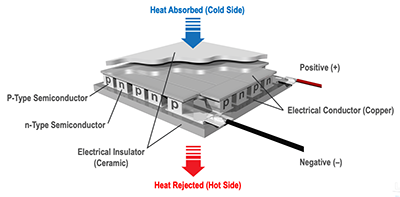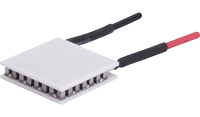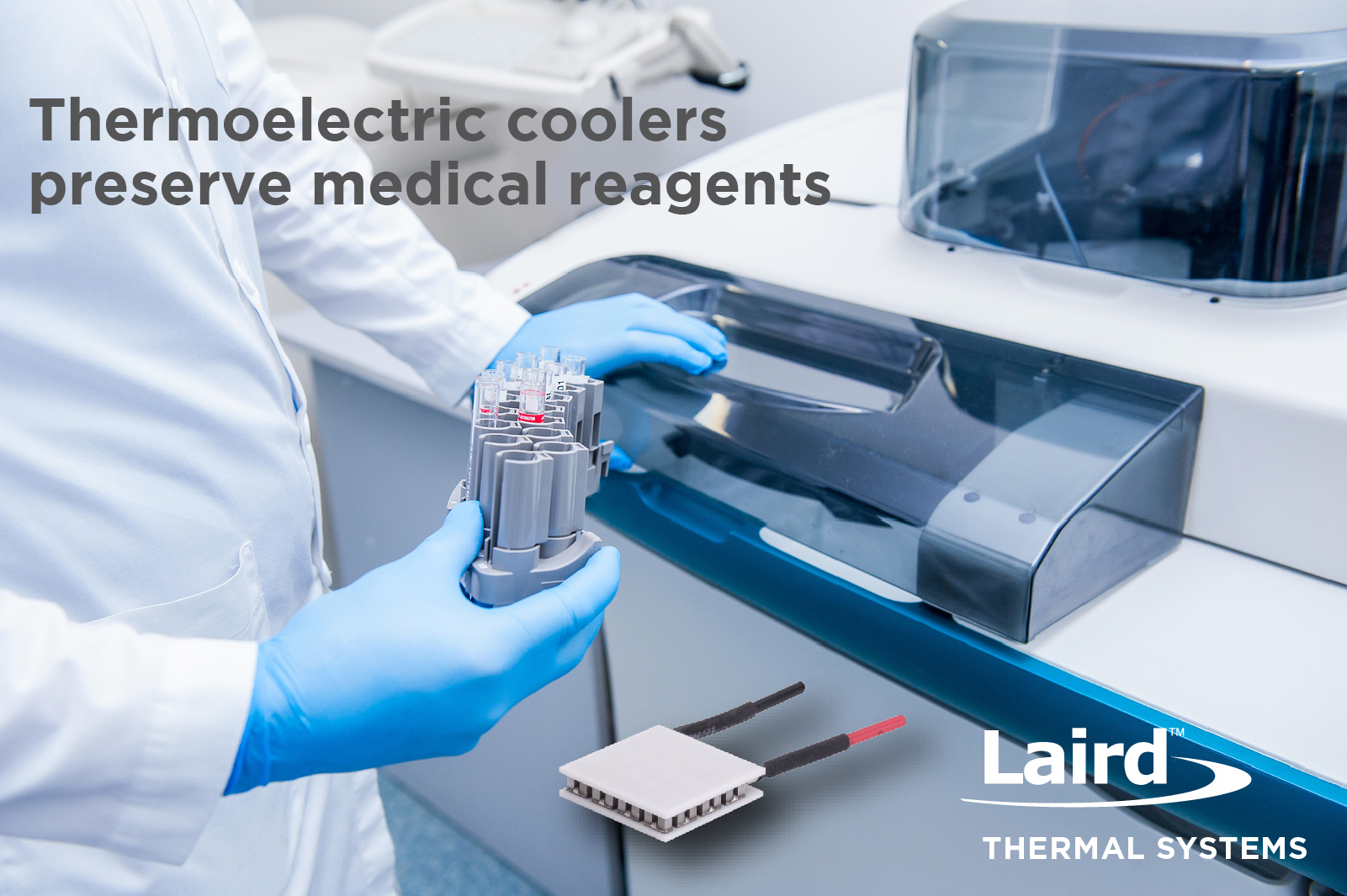Introduction
Analytical chemists use reagents to detect the presence or absence of a substance, or to test if a specific reaction occurs. Laboratory and medical technicians use reagents to cause a chemical or biological reaction to measure or identify a target substance. Biotechnologists consider antibodies, model organisms, oligomers, and specific cell lines as reagents to identify and manipulate cell matter. These reagents, especially those used by the biotechnologist, have narrow operating temperature windows which require refrigeration or freezing. When kept at room temperature, temperature sensitive reagents degrade and may become contaminated by microbial growth, affecting test integrity. Without proper and precise refrigeration, most reagents will deteriorate within hours. In addition, some reagents are negatively affected if stored at too low of a temperature or if subjected to multiple freeze-thaw cycles. Precise temperature stabilization and monitoring below ambient is critical to extend the life of reagents, keep replacement costs down, and ensure accuracy and reliability of laboratory and medical tests.
Active thermoelectric (Peltier) coolers have the precise temperature control ideal for thermal management of reagents. Thermoelectric coolers offer a more efficient, cost-effective and reliable thermal control method compared to other thermal technologies.
Government bans of many refrigerants essential to other thermal technologies also affect reagent storage equipment designs. Refrigerant-free thermoelectric coolers deliver a more environmental friendly solution for temperature control of reagents.
Application Overview
Because of the wide variety of reagents, each reacting differently to storage temperatures, no universal temperature storage standard exists. Laboratory and medical reagent storage systems require different specifications depending on the reagent type and time stored. Storage systems are generally classified into five types based on temperature range control:
Cryogenic freezer → -150ºC to -190ºC
Ultra-low freezer → -85ºC
Standard freezer → -20ºC
Refrigerated → 2ºC to 8ºC
Room temperature → 15ºC to 27ºC
In this application note, we will focus on cooling system requirements and cooling solutions for most reagents, which require refrigerated storage to 2ºC.
Refrigerated temperatures, which range from 2ºC to 8ºC, optimally store frequently used biological reagents including enzymes and antibodies for the short-term. Within this temperature range, most reagent samples experience minor, but acceptable temperature swings. Standard reagent storage systems maintain control temperatures of a reagent tub to 4°C to 6°C at room temperature between 20 to 30°C. Cooling requirements range from 30 to 50 Watts. More advanced medical storage refrigerators, housing extremely temperature sensitive reagents, must keep temperature swings no more than ±2ºC from the thermostat set point.
Application Challenges
In addition to precise temperature control, reagent cooling designs have SWaP (size, weight and power) requirements as well as challenges including lower operating noise, airflow management, condensation mitigation, and temperature alerts. Meeting all these specifications without the use of restricted refrigerants can constrain the thermal design engineer.
Medical instrumentation and diagnostic equipment manufacturers have been tasked with reducing the size of laboratory equipment. The miniaturization of reagent storage equipment to free up precious lab space has led engineers to pack more functionality into a tighter volume. Space constraints within reagent storage systems require thermal control units to have a compact form factor, maximizing storage volume. Packing electronics into a smaller footprint increases the heat flux density. This unwanted heat must be efficiently managed and dissipated to meet conflicting requirements of increased performance with reduced power consumption and quieter operation — all in a smaller design.
Because space is at a premium, installation location and mounting orientation often play a role in the selection of the thermal management solution. Compressor-based systems must mount vertically for proper operation, while thermoelectric devices mount in any orientation. Mounting orientation also plays a role in air flow. Paths for incoming and exiting air must be considered to maximize cooling and/or heating performance.
In reagent storage equipment, thermal management systems not only provide temperature stability, but also condensation protection. As the temperature drops below the dew point, moisture forms on the cold surfaces and may seep into the electronics, causing deterioration and ultimately failure. Good design practice combines a cooling solution resistant to moisture intrusion with properly designed insulation materials.
Many laboratories periodically log the temperature of reagent storage chambers to ensure the integrity of the reagents. While logging temperature is important, knowing for certain if the temperature of a storage chamber diverges beyond the set temperature range has more value. Many medical refrigeration systems feature temperature alarms enabling technicians to act quickly to protect stored reagents.
New environmental regulations, particularly in Europe, have banned the use of specific refrigerants. Older compressor-based systems utilize high global-warming-potential HFC refrigerants including R134a and R404A. The ban has forced many compressor-based refrigeration manufacturers to use natural refrigerants. These modern compressor-based systems use a variety of natural refrigerants: R744 (carbon dioxide), R717 (ammonia), R290 (propane), R600a (isobutene), and R1270 (propylene). Each natural refrigerant, however, presents design challenges such as increased pressure, high toxicity, flammability, asphyxiation, and relatively poor performance. The flammable nature of some natural refrigerants makes them hazardous to transport. This has led manufacturers to seek alternative methods of temperature control such as thermoelectric-based cooling.
Thermoelectric Cooling Solution
Thermoelectric coolers are solid-state heat pump devices which move heat via the Thermoelectric effect. During operation, DC current flows through the thermoelectric cooler creating temperature differential across the module. One side of the thermoelectric cooler gets cold (heat absorption), while the other side heats up (heat dissipation). Thermoelectric coolers usually connect to forced convection heat sinks to the cold side to absorb heat from inside the cabinet, while the hot side heat sink rejects heat to ambient environment. By reversing the polarity of the device, the thermoelectric cooler heats the inside of the cabinet. This dual capability plus control circuitry enables precise temperature control capabilities in one unit.
Thermoelectric coolers deliver accurate temperature control in a more efficient, stable, compact and reliable package compared to other technologies like compressor-based systems. In addition, Thermoelectric coolers are environmentally friendly, as they do not require refrigerants to dissipate heat.
Featuring solid-state construction with no moving parts, thermoelectric coolers operate reliably at low power with no noise – all in a small footprint. Designers have increased integration flexibility with solid-state operation, as thermoelectric devices mount in any orientation.
Laird Thermal Systems Solutions
The CP Series is a rugged, compact thermoelectric cooling product line designed for higher current and larger heat-pumping applications like reagent storage systems. It is typically mounted near the reagent storage chamber to closely regulate chamber temperature. The CP Series direct-to-air configuration offers a maximum cooling power of up to 125 Watts with a temperature difference (ΔT) of 67°C at a room temperature of 25°C. The CP Series is available in a wide range of heat pumping capacities, geometric shapes and input power ranges to meet the wide range of reagent cooling requirements.
Temperature fluctuations can affect the lifetime of a reagent, as they may only last a couple of hours at room temperature before degrading or being contaminated. Tainted reagents influence test results and give invalid results. To ensure reagents remain uncontaminated, proper storage conditions are vital. Thermal designers must consider temperature, condensation, and airflow control when cooling below ambient in reagent storage equipment. Laird Thermal’s space-saving thermoelectric coolers deliver temperature stability and condensation protection for reagent storage equipment. The advantages of thermoelectric coolers over other cooling technologies are precise temperature control, compactness, better efficiency, greater reliability and lower noise. Laird Thermal’s CP Series meets these challenging temperature control requirements.
More information on the CP Series can be found by visiting
https://www.lairdthermal.com/products/product-series/cp-series

